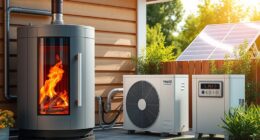Looking for a more efficient way to transfer energy in your home? Look no further – geothermal heat pumps are the solution.
These innovative systems harness the Earth’s natural heat to provide optimal energy transfer. With advanced compressor technology and geothermal loop systems, we can maximize efficiency and reduce energy waste.
Join us as we explore the basics of geothermal heat pumps and discover how they can help serve your energy needs while minimizing environmental impact.
Key Takeaways
- Geothermal heat pumps are highly energy efficient, providing up to four units of heat for every unit of electricity used.
- Understanding thermal energy transfer is crucial for designing efficient geothermal heat pump systems.
- Heat exchangers play a vital role in energy transfer, facilitating heat exchange between the ground and the fluid circulating in geothermal heat pump systems.
- Proper system sizing, control settings optimization, regular maintenance, and advanced compressor technology enhance the efficiency of geothermal heat pump systems.
Geothermal Heat Pump Basics
We’ll now delve into the basics of geothermal heat pumps.

Geothermal heat pump installation involves using the constant temperature of the earth to heat and cool buildings efficiently. These systems work by transferring heat between the earth and a building, providing both heating and cooling functions.
The benefits of geothermal heat pumps are numerous. Firstly, they’re highly energy efficient, as they can provide up to four units of heat for every unit of electricity used. This results in significant energy savings and reduced utility bills. Additionally, geothermal heat pumps have a long lifespan and require minimal maintenance.
They also have a smaller environmental impact compared to traditional heating and cooling systems, as they use renewable energy sources.
Understanding Thermal Energy Transfer
Understanding thermal energy transfer involves comprehending how heat is transferred between different objects or systems, and it’s crucial for maximizing the efficiency of geothermal heat pumps.

Thermal conductivity is a measure of a material’s ability to conduct heat. It determines how quickly heat flows through a material. Materials with high thermal conductivity, such as metals, are efficient at transferring heat. On the other hand, materials with low thermal conductivity, like insulators, are poor conductors of heat.
Heat transfer coefficients, on the other hand, quantify the rate at which heat is transferred between a surface and a fluid. They depend on factors such as the temperature difference between the surface and the fluid, the fluid’s flow rate, and the properties of the fluid and the surface.
Understanding and optimizing these factors are crucial for designing and operating efficient geothermal heat pump systems.
The Role of Heat Exchangers in Energy Transfer
Heat exchangers play a crucial role in the efficient transfer of energy within geothermal heat pump systems. These devices are responsible for facilitating heat exchange between the ground and the fluid circulating in the system.

Heat exchangers function by utilizing various energy transfer mechanisms, such as conduction, convection, and radiation, to effectively transfer thermal energy.
The efficiency of heat exchangers directly impacts the overall performance and energy efficiency of geothermal heat pump systems.
Heat Exchanger Functions
Our heat exchangers play a crucial role in efficiently transferring energy in geothermal heat pump systems. Here are four key functions of heat exchangers:
-
Heat Transfer: Heat exchangers facilitate the transfer of heat between two fluids. In geothermal heat pumps, the heat exchanger absorbs heat from the Earth’s crust and transfers it to the refrigerant fluid circulating in the system.
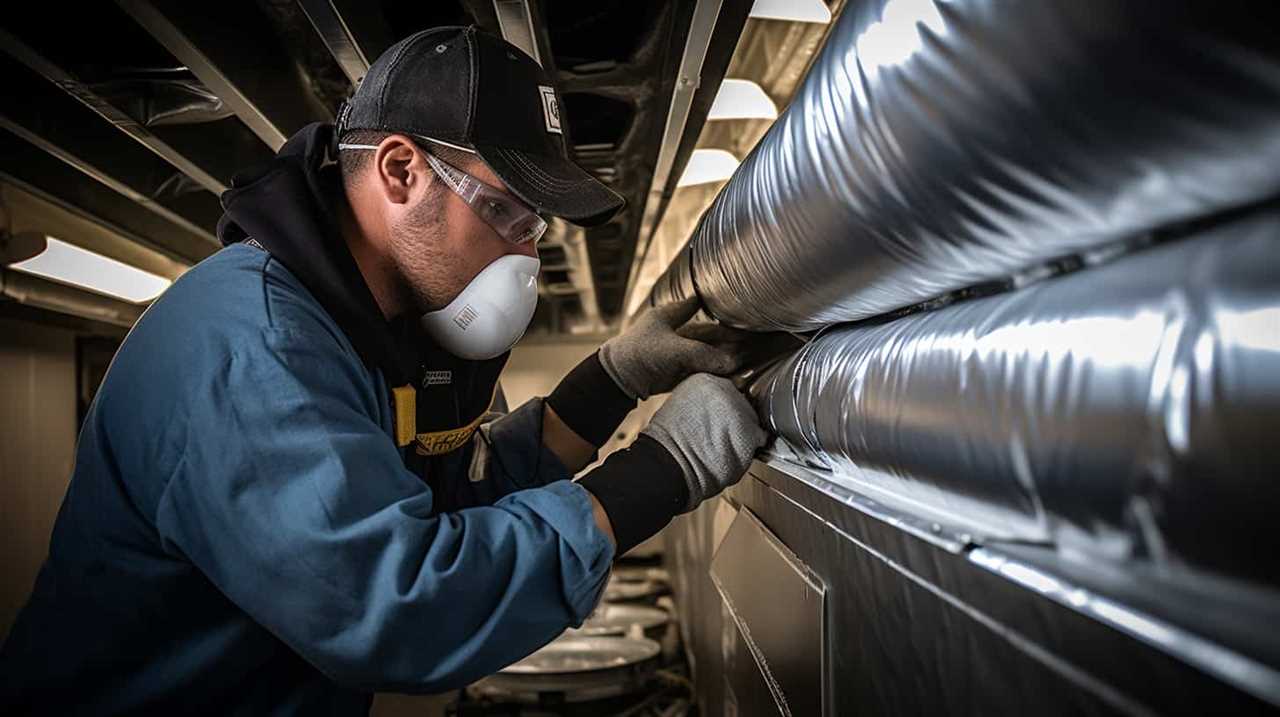
-
Refrigerant Evaporation: The heat exchanger allows the refrigerant to evaporate by absorbing heat from the surrounding air or water. This phase change enables the heat pump to extract and utilize the heat energy effectively.
-
Condensation: After absorbing heat, the refrigerant releases it in the heat exchanger, causing it to condense back into a liquid state. This process releases the heat energy into the desired space.
-
Efficiency Enhancement: By maximizing heat transfer between the refrigerant and the surrounding medium, heat exchangers improve the overall efficiency of geothermal heat pump systems.
Proper heat exchanger maintenance and the use of high-quality heat exchanger materials are crucial to ensuring optimal energy transfer and system performance.

Energy Transfer Mechanisms
Let’s delve into how heat exchangers actively facilitate energy transfer in geothermal heat pump systems. Heat exchangers play a crucial role in the efficient transfer of energy between different mediums in a geothermal heat pump system. They allow for the transfer of thermal energy from the ground to the working fluid, and then from the working fluid to the conditioned space. This transfer is achieved through the use of a fluid, such as water or refrigerant, which circulates through the heat exchanger. The heat exchanger maximizes the contact area between the fluid and the medium it is exchanging heat with, such as the ground or the indoor air. This ensures efficient energy transfer by utilizing the thermal conductivity of the mediums involved. The table below provides a comparison of different types of heat exchangers commonly used in geothermal heat pump systems:
| Heat Exchanger Type | Advantages | Disadvantages |
|---|---|---|
| Coaxial | – Compact design |
- High heat transfer efficiency | – Limited by borehole size
- Difficult to repair |
| Vertical | – Suitable for limited space - Cost-effective | – Requires drilling deep boreholes
- Lower heat transfer efficiency |
| Horizontal | – Easy installation - Suitable for large areas | – Requires a larger land area
- Lower heat transfer efficiency |
| Plate | – High heat transfer efficiency - Compact design | – Prone to fouling
- High pressure drop |
Understanding the energy transfer mechanisms and the different types of heat exchangers used in geothermal heat pump systems is crucial for optimizing their efficiency. In the next section, we will explore the efficiency of heat exchangers and how it impacts the overall performance of the system.
Efficiency of Heat Exchangers
To ensure optimal performance, we need to understand how heat exchangers contribute to energy transfer efficiency in geothermal heat pump systems. Here are four key factors to consider in heat exchanger design for maximizing energy transfer efficiency:
-
Surface Area: A larger surface area allows for more effective heat transfer between the fluid circulating in the heat exchanger and the surrounding environment.

-
Fluid Flow Rate: Proper fluid flow rate ensures efficient heat transfer by maintaining a balance between maximizing heat exchange and minimizing pressure drop.
-
Material Conductivity: Choosing heat exchanger materials with high thermal conductivity allows for better heat transfer, reducing energy losses.
-
Fouling Resistance: Heat exchanger designs that minimize fouling, such as using smooth surfaces or incorporating effective cleaning mechanisms, can help maintain energy transfer efficiency over time.
Maximizing Efficiency With Geothermal Heat Pumps
We can enhance the efficiency of geothermal heat pumps by optimizing their performance. Maximizing performance starts with proper geothermal system sizing. It’s important to accurately calculate the heating and cooling loads of the building to determine the appropriate size of the heat pump. Oversizing or undersizing the system can lead to inefficient operation and reduced performance.

Additionally, optimizing the control settings of the heat pump can further improve efficiency. Setting the temperature differentials, flow rates, and operating schedules to match the building’s needs can minimize energy wastage.
Regular maintenance, including cleaning the heat exchanger and checking for refrigerant leaks, is also crucial for optimal performance. By implementing these strategies, we can ensure that geothermal heat pumps operate at their highest efficiency, providing efficient energy transfer.
Now, let’s delve into the next section, which focuses on heat pump compressor technology for efficient energy transfer.
Heat Pump Compressor Technology for Efficient Energy Transfer
When it comes to efficient energy transfer in geothermal heat pumps, two key factors play a crucial role: enhanced heat transfer techniques and energy-saving compressor designs.
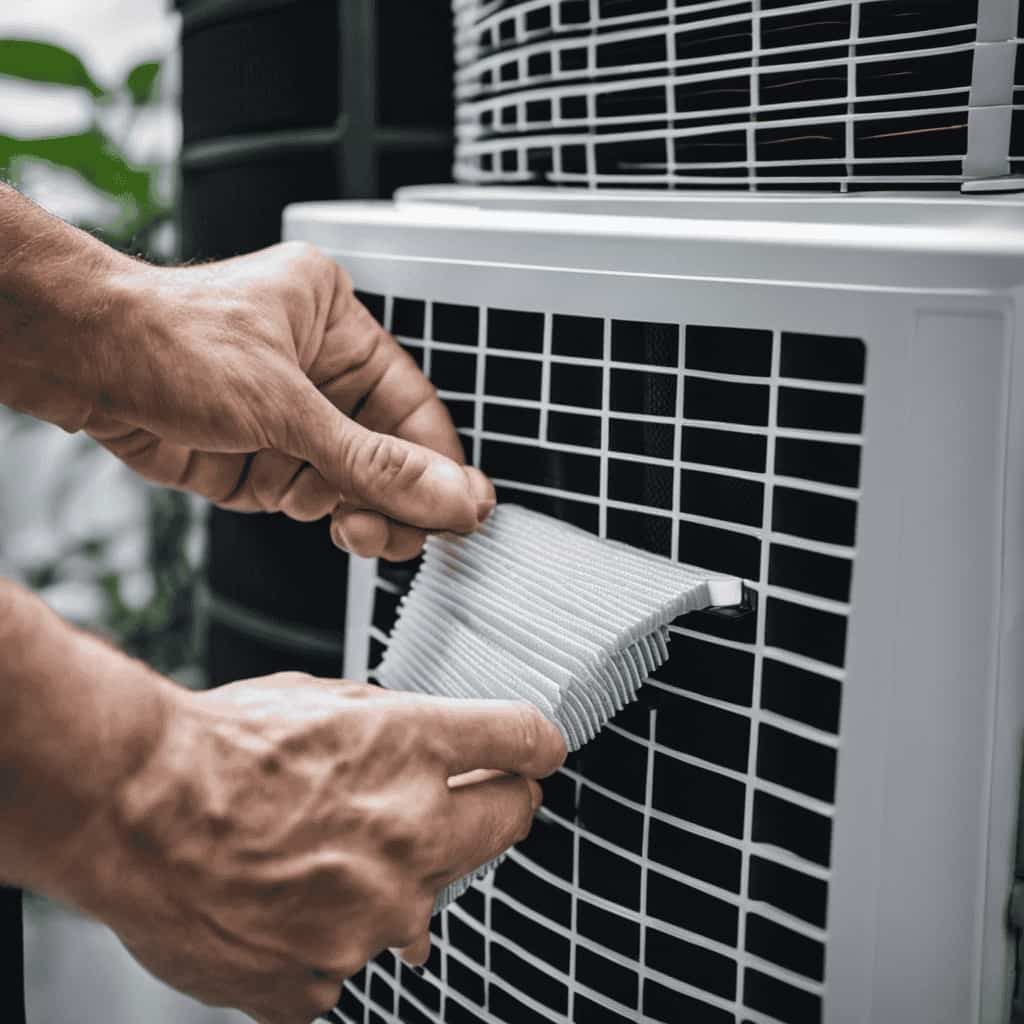
By implementing advanced heat transfer techniques, such as multi-stage heat exchangers and plate heat exchangers, the system can maximize the transfer of thermal energy between the ground and the working fluid.
Additionally, energy-saving compressor designs, such as variable-speed compressors and scroll compressors, allow for better control of the refrigerant flow and reduce energy consumption, resulting in higher overall efficiency.
Enhanced Heat Transfer Techniques
Our research shows that using advanced heat pump compressor technology can significantly improve the energy transfer efficiency of geothermal heat pumps. Here are four enhanced heat transfer techniques that can be implemented in innovative geothermal applications:
-
Variable Speed Compressors: These compressors can adjust their speed based on the heating or cooling demand, allowing for precise temperature control and more efficient energy transfer.

-
Scroll Compressors: These compressors use a scroll-like mechanism to compress the refrigerant, resulting in higher efficiency and lower energy consumption compared to traditional piston compressors.
-
Two-Stage Compressors: These compressors have two stages of compression, allowing for better control of temperature and improved energy transfer in both heating and cooling modes.
-
Plate Heat Exchangers: These heat exchangers use a series of metal plates to transfer heat between the refrigerant and the ground loop fluid, maximizing the heat exchange surface area and enhancing energy transfer.
These enhanced heat transfer techniques pave the way for the subsequent section about energy-saving compressor designs, which further improve the efficiency of geothermal heat pumps.

Energy-Saving Compressor Designs
By incorporating energy-saving compressor designs, we can further enhance the efficiency of geothermal heat pumps by improving heat pump compressor technology for efficient energy transfer.
Energy-saving compressor technologies play a crucial role in reducing energy consumption and maximizing the performance of geothermal heat pumps. These innovative designs optimize the compression process, resulting in higher energy efficiency and lower operating costs.
By utilizing advanced technologies such as variable speed compressors and scroll compressors, geothermal heat pumps can adjust their output according to the heating or cooling demand, minimizing energy wastage.
Additionally, the integration of innovative heat exchanger designs further improves the overall efficiency of geothermal heat pumps by enhancing heat transfer rates.
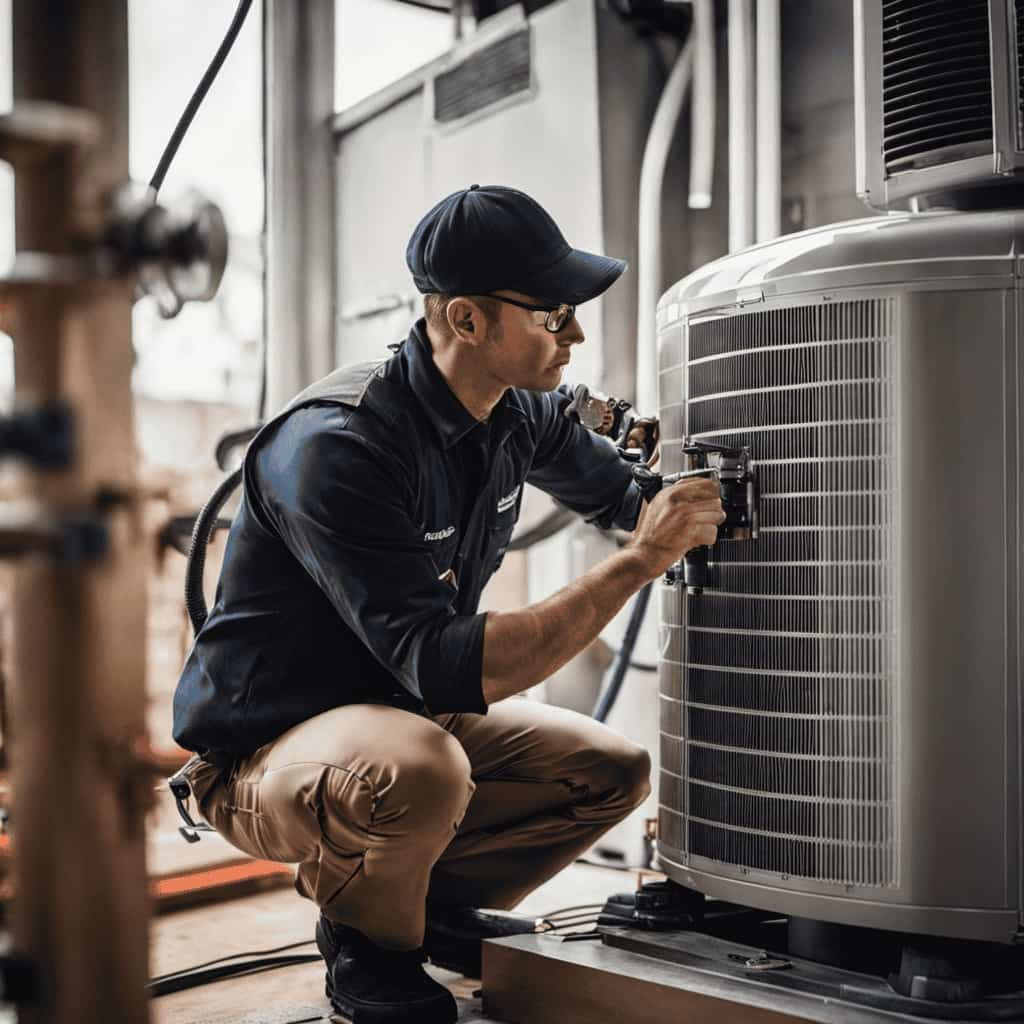
These advancements in compressor technology and heat exchanger design enable geothermal heat pumps to harness the earth’s natural heat more efficiently, ensuring optimal energy transfer for heating and cooling purposes.
Harnessing Earth’s Natural Heat for Energy Transfer
We can harness the Earth’s natural heat by extracting it through geothermal heat pumps. Geothermal energy has several advantages for power generation, making it a sustainable and efficient option for serving our energy needs. Here is a list of advantages:
-
Renewable: Geothermal energy is derived from the Earth’s heat, which is constantly replenished.
-
Environmentally Friendly: Geothermal power generation produces minimal greenhouse gas emissions and has a small footprint.

-
Cost-Effective: Geothermal energy can reduce energy bills by up to 50% compared to traditional heating and cooling systems.
-
Reliable: Geothermal heat pumps provide a consistent and reliable source of heating and cooling throughout the year, regardless of external weather conditions.
Exploring Geothermal Loop Systems
Exploring the efficiency of geothermal loop systems is crucial for maximizing the potential of geothermal heat pumps in energy transfer. Geothermal loop design and installation play a significant role in the overall performance and effectiveness of geothermal heat pump systems.
To better understand the importance of geothermal loop systems, let’s consider the following table:

| Geothermal Loop Design | Geothermal Loop Installation |
|---|---|
| Proper sizing and layout | Professional expertise |
| Efficient heat transfer | Correct depth and spacing |
| High-quality materials | Proper sealing and insulation |
| Adequate flow rate | Accurate pipe placement |
By focusing on geothermal loop design, we ensure that the system is appropriately sized and laid out, maximizing heat transfer efficiency. Additionally, high-quality materials and proper sealing and insulation help minimize energy loss. Geothermal loop installation by professionals ensures correct depth, spacing, and pipe placement, allowing for optimal heat exchange.
Understanding the intricacies of geothermal loop systems facilitates the effective use of geothermal heat pumps, helping to serve others by providing efficient and sustainable energy transfer.
The Importance of Insulation in Energy Transfer
How does insulation impact energy transfer in geothermal heat pump systems?
Insulation plays a crucial role in ensuring efficient energy transfer in geothermal heat pump systems. Here are four key ways insulation techniques and energy-saving materials contribute to optimizing energy transfer:
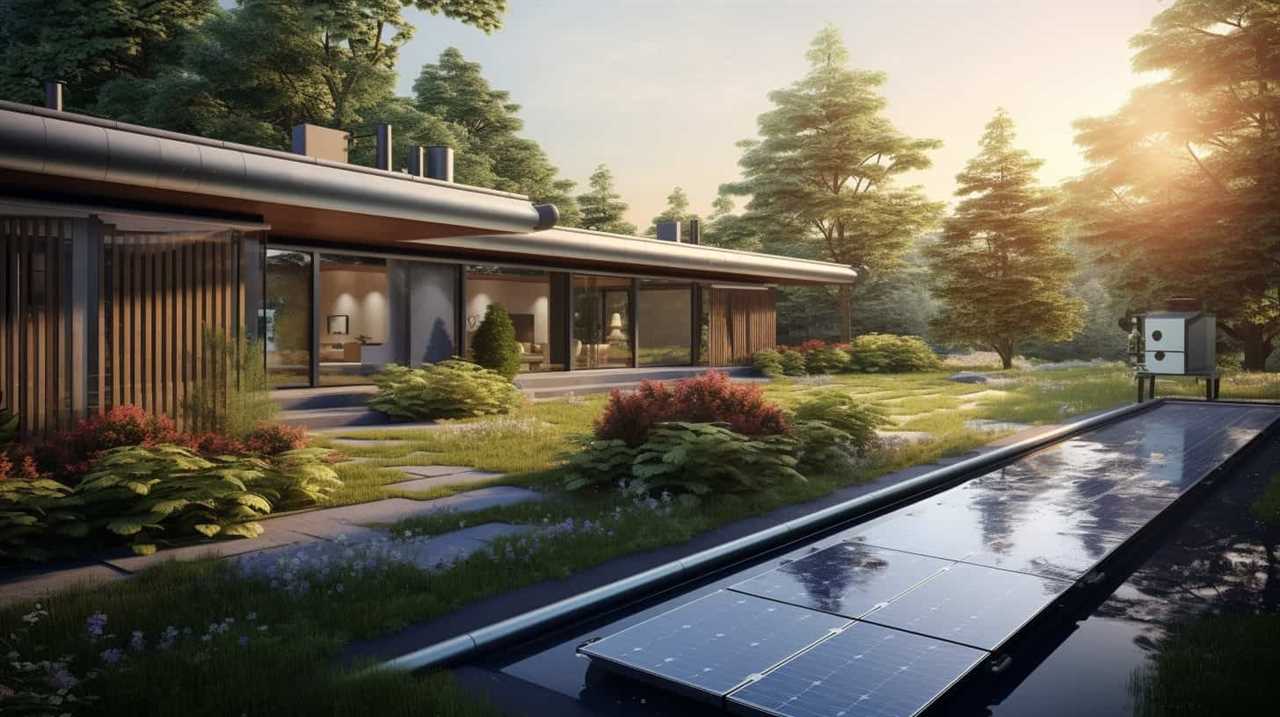
-
Minimizing heat loss: Insulation materials, such as foam boards or fiberglass batts, help prevent heat from escaping or entering the system, reducing energy waste.
-
Maintaining temperature stability: Effective insulation prevents temperature fluctuations, ensuring consistent and reliable energy transfer throughout the system.
-
Reducing energy consumption: By minimizing heat loss, insulation reduces the load on the geothermal heat pump, resulting in lower energy consumption and cost savings.
-
Enhancing system performance: Proper insulation allows the geothermal heat pump system to operate at its optimal efficiency, maximizing energy transfer and overall performance.

Investing in insulation techniques and energy-saving materials is crucial for achieving energy-efficient and cost-effective geothermal heat pump systems.
Optimizing Energy Transfer in Geothermal Heat Pump Systems
To optimize energy transfer in geothermal heat pump systems, maximizing efficiency and minimizing waste are essential. This can be achieved through advancements in geothermal heat pump technology and optimizing system performance. By implementing these strategies, we can ensure that the energy transfer process is as efficient as possible, resulting in lower energy costs and reduced environmental impact.
One way to optimize system performance is by utilizing variable speed technology. This allows the heat pump to adjust its speed and capacity based on the heating or cooling demands of the space, resulting in more precise temperature control and reduced energy consumption.
Additionally, incorporating advanced controls and sensors can help monitor and regulate the system, ensuring optimal performance and energy efficiency. By continuously analyzing and adjusting the system’s operation, we can maximize energy transfer while minimizing waste.

In summary, optimizing energy transfer in geothermal heat pump systems requires staying up-to-date with the latest advancements and technologies. By implementing these strategies, we can achieve maximum efficiency and reduce energy waste.
| Strategies for Optimizing Energy Transfer | Benefits |
|---|---|
| Utilizing variable speed technology | Precise temperature control, reduced energy consumption |
| Incorporating advanced controls and sensors | Optimal system performance, increased energy efficiency |
| Continuously analyzing and adjusting system operation | Maximum energy transfer, minimized waste |
Frequently Asked Questions
How Much Does It Cost to Install a Geothermal Heat Pump System?
Geothermal heat pump installation costs vary depending on factors such as location, system size, and site conditions. However, the long-term energy savings from geothermal heat pumps can offset the initial investment over time.
Are Geothermal Heat Pumps Suitable for All Types of Buildings?
Geothermal heat pumps are suitable for most buildings, but efficiency varies. Challenges in installation include site suitability, drilling depths, and cost. We recommend consulting professionals to determine the best solution for your specific needs.
Are There Any Government Incentives or Tax Credits Available for Installing a Geothermal Heat Pump System?
Yes, there are government incentives and tax credits available for installing a geothermal heat pump system. These incentives and credits help make the transition to more efficient and sustainable energy sources more affordable for homeowners and businesses.

Can a Geothermal Heat Pump System Be Used for Both Heating and Cooling?
Yes, a geothermal heat pump system can be used for both heating and cooling. It is an efficient energy transfer method that utilizes the stable temperature of the earth to provide year-round comfort. The advantages of geothermal heat pumps include high efficiency and cost savings.
How Long Does It Take to Recover the Initial Investment in a Geothermal Heat Pump System Through Energy Savings?
It typically takes around 5-10 years to recover the initial investment in a geothermal heat pump system through energy savings. This is due to the high efficiency and low maintenance required for geothermal heat pumps.
Conclusion
In conclusion, geothermal heat pumps offer an incredibly efficient and sustainable way to transfer thermal energy. They make use of advanced heat exchanger technology and compressor systems to maximize efficiency. By harnessing the Earth’s natural heat through geothermal loop systems, we can significantly reduce energy consumption and lower our carbon footprint.
The importance of insulation can’t be overstated in optimizing energy transfer. Geothermal heat pumps are truly a game-changer in the field of energy efficiency, revolutionizing the way we heat and cool our homes and buildings.








